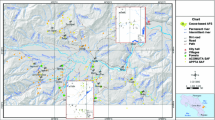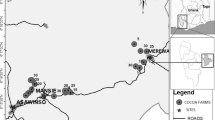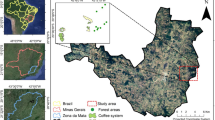Abstract
This paper seeks to examine the contribution of cocoa-based agroforestry systems (CAFS) in the conservation of native tree species of nearby forests. The study was conducted in two sites in Mbankomo sub-division of Cameroon, where a field inventory was carried out in both land use systems in 26 sample plots of 30 × 30 m2 each, in 20 cocoa agroforest plots and six adjacent secondary forests plots. Tree diversity, composition and structure in the cocoa agroforests and secondary forests were characterized, α-diversity was evaluated and similarity/dissimilarity of species composition assessed using non-metric multidimensional scaling (NMDS). The results reveal that all the CAFS appear to conserve 46 % of forest tree species found in nearby forests. This may be justified by the multipurpose use of forest tree species during the implementation and the evolution of the CAFS on a spatial–temporal scale. CAFS harbored lower forest tree species diversity at the plot level compared to nearby forest stands meanwhile the non-parametric estimator suggested that both land uses conserve approximately the same species richness. Mean values for species richness, the Shannon and reciprocal Simpsons indices diversity, stem density and basal area were significantly higher in forests than in CAFS (p < 0.001). The NMDS showed a clear dissimilarity which was confirmed by the Rstatistic = 0.998 and p value = 0.009 of the analysis of similarities test between cocoa agroforests and forest stands. In conclusion, the results show that CAFS can serve as reservoirs for the conservation of forest tree species; this can be expanded if the issue of ownership of timber forest trees is addressed in the forest law.



Similar content being viewed by others
References
Amanor KS (1996) Managing trees in the farming system: the perspective of farmers, vol 1. Forest Farming Forestry Department, Kumasi
Anglaaere LCN, Cobbina J, Sinclair FL, McDonald MA (2011) The effect of land use systems on tree diversity: farmer preference and species composition of cocoa-based agroecosystems in Ghana. Agrofor Syst 81:249–265. doi:10.1007/s10457-010-9366-z
Asare R (2005) Cocoa agroforests in West Africa: a look at activities on preferred trees in the farming systems. Forest & Landscape, Hørsholm
Asare R (2006) A review on cocoa agroforestry as a means for biodiversity conservation. Paper presented at the World Cocoa Foundation Partnership conference, Landscape Fa, Brussels
Asare R, Afari-Sefa V, Osei-Owusu Y, Pabi O (2014) Cocoa agroforestry for increasing forest connectivity in a fragmented landscape in Ghana. Agrofor Syst 88:1143–1156. doi:10.1007/s10457-014-9688-3
Bisseleua DHB, Vidal S (2008) Plant biodiversity and vegetation structure in traditional cocoa forest gardens in southern Cameroon under different management. Biodivers Conserv 17:1821–1835. doi:10.1007/s10531-007-9276-1
Bobo SK, Waltert M, Sainge MN, Njokagbor J, Fermon H, Mühlenberg M (2006) From forest to farmland: species richness patterns of trees and understorey plants along a gradient of forest conversion in Southwestern Cameroon. Biodivers Conserv 15:4097–4117
Burnham KP, Overton WS (1979) Robust estimation of population size when capture probabilities vary among animals. Ecology 60:927–936
Cerda R, Deheuvels O, Calvache D, Niehaus L, Saenz Y, Kent J, Vilchez S, Villota A, Martinez C, Somarriba E (2014) Contribution of cocoa agroforestry systems to family income and domestic consumption: looking toward intensification. Agrofor Syst 88:957–981. doi:10.1007/s10457-014-9691-8
Chao A (1984) Non-parametric estimation of the number of classes in a population. Scand J Statist 11:265–270
Clough Y, Putra DD, Pitopang R, Tscharntke T (2009) Local and landscape factors determine functional bird diversity in Indonesian cacao agroforestry. Biol Conserv 142:1032–1041. doi:10.1016/j.biocon.2008.12.027
Curtis JT, McIntosh RP (1951) An upland forest continuum in the prairie-forest border region of Wisconsin. Ecology 32:476–496
Deheuvels O, Rousseau GX, Quiroga GS, Franco MD, Cerda R, Mendoza SJV, Somarriba E (2014) Biodiversity is affected by changes in management intensity of cocoa-based agroforests. Agrofor Syst 88:1081–1099. doi:10.1007/s10457-014-9710-9
Duguma B, Gockowski J, Bakala J (2001) Smallholder cacao (Theobroma cacao Linn.) cultivation in agroforestry systems of West and Central Africa: challenges and opportunities. Agrofor Syst 51:177–188
Eyog Matig O, Ndoye O, Kengue J, Awono A (eds) (2006) Les fruitiers forestiers comestibles du Cameroun. Cotonou, IPGRI/SAFORGEN/IRAD/CIFOR
Fox J (2005) The R commander: a basic statistics graphical user interface to R. J Stat Softw 14:1–42
Gockowski J, Sonwa D (2011) Cocoa intensification scenarios and their predicted impact on CO2 emissions, biodiversity conservation, and rural livelihoods in the Guinea rain forest of West Africa. Environ Manag 48:307–321
Gockowski J, Onye J, Baker D, Legg C, Weise S, Ndoumbe M, Tiki-Manga T, Fouaguegue A (2004) Characterization and diagnosis of farming systems in the forest margins benchmark of Southern Cameroon. IITA Social Sciences Working Paper No 1 Ibadan
Gockowski J, Tonye J, Diaw C, Hause S, Kotto-Same J, Njomgang R, Moukam A, Nwaga D, Tiki-Manga T, Tondoh J, Tschondeau Z, Weise S, Zapfack L (2005) The forest margins of Cameroon. In: Palm CA, Vosti SA, Sanchez PA, Ericksen PJ (eds) Slashand-burn agriculture: the search for alternatives. Columbia University Press, New York, pp 305–331
Gockowski J, Tchatat M, Dondjang JP, Hietet G, Fouda T (2010) An empirical analysis of the biodiversity and economic returns to cocoa agroforests in Southern Cameroon. J Sustain For 29:638–670. doi:10.1080/10549811003739486
Gockowski J, Afari-Sefa V, Sarpong DB, Osei-Asare YB, Agyeman NF (2013) Improving the productivity and income of Ghanaian cocoa farmers while maintaining environmental services: what role for certification? Int J Agric Sustain 11:331–346. doi:10.1080/14735903.2013.772714
Greenberg R, Bichier P, Cruz Anglon A (2000) The conservation value for birds of cacao plantations with diverse planted shade in Tabacco, Mexico. Anim Conserv 3:105–112
IUCN (2015) IUCN Red List of Threatened Species. Version 11. http://www.iucnredlist.org/search
Jagoret P, Todem Ngogue H, Bouambi E, Battini JL, Nyassé S (2009) Diversification des exploitations agricoles à base de cacaoyer au Centre Cameroun: mythe ou réalité? Biotechnol Agron Soc Environ 13:271–280
Jiofack T, Guedje NM, Tchoundjeu Z, Fokunang C, Lejoly J, Kemeuze V (2013) Agroforestry typology of some cocoa based agroforests in the Mbam and Inoubou division: the importance for local population livelihoods. J Ecol Nat Environ 5:378–386. doi:10.5897/JENE12.085
Kindt R, Coe R (2005) Tree diversity analysis. A manual and software for common statistical methods for ecological and biodiversity studies. World Agroforestry Centre (ICRAF), Nairobi
Kotto-Same J, Woomer PL, Moukam A, Zapfack L (1997) Carbon dynamics in slash-and-bum agriculture and land use alternatives of the humid forest zone in Cameroon. Agric Ecosyst Environ 65:245–256
Laird SA, Leke Awung G, Lysinge RJ (2007) Cocoa farms in the Mount Cameroon region: biological and cultural diversity in local livelihoods. Biodivers Conserv 16:2401–2427
Leakey RRB, Tchoundjeu Z (2001) Diversification of tree crops: domestication of companion crops for poverty reduction and environmental services. Exp Agric 37:279–296
Letouzey R (1985) Notice de la carte phytogéographique du Cameroun au 1/500.000. Institut de la carte internationale de la végétation, Toulouse
Nair PKR (2012) Carbon sequestration studies in agroforestry systems: a reality-check. Agrofor Syst 86:243–253. doi:10.1007/s10457-011-9434-z
Oke DO, Odebiyi KA (2007) Traditional cocoa-based agroforestry and forest species conservation in Ondo State, Nigeria. Agric Ecosyst Environ 122:305–311
Onana JM (2011) The vascular Plant of Cameroon a taxonomic checklist with UICN assessments. IRAD—National Herbarium of Cameroon, Yaounde
Philpott S, Armbrecht I (2006) Biodiversity in tropical agroforests and the ecological role of ants and ant diversity in predatory function. Ecol Entomol 31:369–377
R Core team (2014) R: A language and environment for statistical computing. R Foundation for Statistical Computing, Vienna. http://www.R-project.org
Rolim SG, Ciarello AG (2004) Slow death of Atlantic forest trees in cocoa agroforestry in southeastern Brazil. Biodivers Conserv 13:2679–2694
Ruf FO (2011) The myth of complex cocoa agroforests: the case of Ghana. Hum Ecol 39:373–388
Ruf F, Zadi H (1998) Cocoa: from deforestation to reforestation. Paper from workshop on Shade Grown Cocoa held in Panama, Washington DC
Schulze CH, Waltert M, Kessler PJA, Pitopang R, Shahabuddin Veddeler D, Mühlenberg M, Gradstein RS, Leuschner C, Steffan-Dewenter I, Tscharntke T (2004) Biodiversity indicator groups of tropical landuse systems: comparing plants, birds, and insects. Ecol Appl 14:1321–1333
Somarriba E, Cerda R, Orozco L, Cifuentes M, Dávila H, Espin T, Mavisoy H, Ávila G, Alvarado E, Poveda V, Astorga C, Say E, Deheuvels O (2013) Carbon stocks and cocoa yields in agroforestry systems of Central America. Agric Ecosyst Environ 173:46–57
Sonwa DJ, Weise SF, Tchatat M, Nkongmeneck BA, Adesina AA, Ndoye O, Gockowski J (2001) The role of cocoa agroforests in rural and community forestry in southern Cameroon. Rural Development Forestry Network, London
Sonwa DJ, Nkongmeneck BA, Weise SF, Tchatat M, Adesina AA, Janssens MJJ (2007) Diversity of plants in cocoa agroforests in the humid forest zone of southern Cameroon. Biodivers Conserv 16:2385–2400
Sonwa DJ, Weise SF, Nkongmeneck BA, Tchatat M, Janssens MJJ (2009) Carbon stock in smallholder chocolate forest in southern Cameroon and potential role in climate change mitigation. IOP Conference Series: Earth and Environmental Science 6
Tscharntke T, Clough Y, Bhagwat SA, Buchori D, Faust H, Hertel D, Holscher D, Juhrbandt J, Kessler M, Perfecto I, Scherber C, Schroth G, Veldkamp E, Wanger TC (2011) Multifunctional shade-tree management in tropical agroforestry landscapes—a review. J Appl Ecol. doi:10.1111/j.1365-2664.2010.01939.x
UNFCCC (2002) Report of the conference of the parties on its seventh session, held at Marrakesh from 29 October to 10 November 2001 (FCCC/CP/2001/13/Add.1, UNFCCC, Marrakesh, Morocco [WWW document]. http://unfccc.int/resource/docs/cop7/13a01.pdf. Accessed Apr 4, 2016
Vallerie M (1973) Contribution à l’étude des sols du Centre-Sud Cameroun: type de différenciation morphologique et pédogénétique sous climat sub équatorial. Zeitschrift für Pflanzenernährung und Bodenkunde, Paris
Vivien J, Faure JJ (2011) Arbres des forêts denses d’Afrique Centrale. Ministère des Relations Extérieures, Coopération et Développement et Agence de Coopération Cuturelle et Technique, Paris
Wilks C, Issembé Y (2000) Guide pratique d’identification: les arbres de la Guinée Equatoriale: Région continentale. Projet Curet Bata, Guinée Equatoriale, Prépresse Communications, Paris
Zapfack L, Engwald S, Sonke B, Achoundong G, Madong BA (2002) The impact of land conversion on plant biodiversity in the forest zone of Cameroon. Biodivers Conserv 11:2047–2061
Acknowledgments
The authors wish to thanks His Majesty, Chief Messa Pierre of Nkoltsit village, for all the facilities he provided during the field work. The authors also thank all the farmers of Nkoltsit and Ossa localities for their cooperation and hospitality during all the study period.
Author information
Authors and Affiliations
Corresponding author
Rights and permissions
About this article
Cite this article
Abada Mbolo, M.M., Zekeng, J.C., Mala, W.A. et al. The role of cocoa agroforestry systems in conserving forest tree diversity in the Central region of Cameroon. Agroforest Syst 90, 577–590 (2016). https://doi.org/10.1007/s10457-016-9945-8
Received:
Accepted:
Published:
Issue Date:
DOI: https://doi.org/10.1007/s10457-016-9945-8




